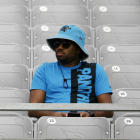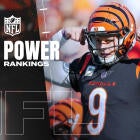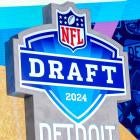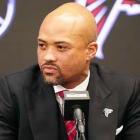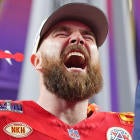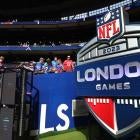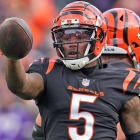
The NFL doesn't care whether you think it's unfair that some teams will have fans in the stands this season and others won't. I don't care either.
In the past two weeks I've gotten more questions about the perceived unfairness of the league's lack of a uniform rule from stadium to stadium than anything else. We have heard from Vikings head coach Mike Zimmer and Bills head coach Sean McDermott bemoaning the competitive disadvantages.
First of all, I do not believe there will be any perceptible difference between playing in front of a stadium that's one-fifth full and playing in front of no fans. Secondly, it makes plenty of financial sense why the league is leaving the decision up to individual teams based on local guidelines.
"I think it's honestly ridiculous that there will be ... what appears to be a playing field that is like that," McDermott said this week. "Inconsistency across the league with the different away stadiums. We control what we can control. That's gotta be our mindset and that's how we attack it."
As it stands now, only five teams have announced they'll have fans in the stands to start the season: Indianapolis, Tampa Bay, Jacksonville, Kansas City and Miami. (Four other teams have yet to make their announcement.) By my count, none of those five teams will have more than 25-30 percent capacity.
Looking for some late-round picks that could win your fantasy league? Establish The Run's Evan Silva joins Will Brinson on the Pick Six Podcast to break down that and more fantasy tips; listen below and be sure to subscribe for daily NFL goodness.
For my three-part series in the spring predicting what teams are currently facing, I spoke with Thomas Dohmen about how home-field advantage could be impacted with no or few fans in the stands. Dohmen is a professor of applied microeconomics at University of Bonn and author of one of the foremost studies on the topic of home-field advantage.
The point that he and others have made is that officiating bias has the greatest impact on home-field advantage. In short, otherwise impartial officials make close calls in close games for the home team when they are subconsciously influenced by the massive crowd that is around and on top of them.
"The referee is slightly more biased if the home crowd has a higher chance of putting pressure on the referee, social pressure," Dohmen told me in April. "So closeness to the pitch, mass of the crowd, these factors do seem to play a role."
His study looked at German soccer, and he found that home-field advantage diminished when there was a track around the pitch that buffered officials from the fans. No NFL stadium has a track around it, but this season all stadiums will have the first six-to-eight rows tarped off for advertising. Whatever number of fans in the stands will now be farther away from influencing officials.
"The effect of the size of the crowd is negligible," Dohmen continues. "It goes in the right direction [for home-field advantage] but it's negligible. What's probably more important than the size of the crowd, which is also suggested by other studies that tried to replicate it, is the concentration. If you have a small, packed stadium that is probably better than a large stadium with the same amount of people."
So 20,000 people in a 20,000-seat stadium has a greater impact than those same people in a 70,000-seat stadium, which is what we'll get this season in a few NFL venues.
That doesn't mean having no or few fans won't have an impact on players. As I wrote in the spring, team composition will be important. A player who is prone to choking in front of large crowds may play better in front of no one. A player who may time slower at the combine but play with greater "football speed" may struggle with no one around.
Jeff Miller, the NFL's EVP of communications, public affairs and policy, was asked about the perceived competitive imbalance on a conference call with reporters earlier this week. To say he dodged the point of the question would be a polite way of putting it. Miller didn't address the possible inequities but simply said the decision rests with each team and their respective state and local health guidelines.
Like everything, the decision to allow teams to make their own decisions is about money. The more fans are in stands across the country, the less the salary cap deficit in 2021 and beyond when all the revenue is tallied from this season. But even away from the field, more fans means more people get to keep their jobs. I wrote last week about how Panthers owner David Tepper has laid off or furloughed at least 30 people since the start of the pandemic, and people on the business side of teams across the league have been holding their collective breath wondering if they'll still have jobs if fans aren't there. Teams hitting their break-even point around 20 percent capacity may reflect many in entertainment/stadium ops/ticketing roles keeping their jobs this fall.
Home-field advantage has been steadily decreasing over the decades, and 2020 offers a great experiment for what really drives it. I don't believe a few thousand people in a cavernous stadium spread out 6 feet apart will truly have an impact on any of the 256 regular-season outcomes this year, and I'm hopeful that those few thousands of people will help team owners decide to keep their workers employed.
Player tickets a tricky issue
One player perk that is diminishing, or altogether disappearing, this season is the free family ticket. I'm told free tickets for players' families will be at the discretion of each team rather than having some collectively bargained policy across the league for stadiums allowing fans.
A source at one team that's expecting to have fans this season said they are giving two free tickets to players. That's no different than past years, but there will only be a "limited" number of tickets players can buy in addition to the two freebies. In past years there was generally no limit on those extra tickets.
It's a tricky issue for the players union and teams. The union's purpose is to support the players fully, and the players certainly want as many family members and loved ones as possible to be able to watch them play in person. Teams want that as well, but they also can't give away too many tickets. There are long-time season-ticket holders, representing your team's best customers, who can't be left in the cold, and revenue can't fly out the window in a year where every team will experience a financial hit.
As mentioned above, a financial break-even point for teams is probably around 20 percent capacity. There are some clubs that are allowed by local law to have fans in September but have opted not to because such low fan attendance represents low gate revenue that won't equal what it costs to staff the event.
No hotel visits
I took another look over the travel protocols for NFL teams this week after reporting it through last week, and something jumped out at me.
Under the physical distancing portion of the team travel protocols lies this nugget: "Coaches and players must have their own hotel rooms. Members of the Traveling Party may not make separate public or private housing arrangements while traveling. Room visits are permitted only by members of the Traveling Party."
That last sentence reads to me like a simple and elegant way of telling players not to have any … friendly visits on the road.
The NBA made waves earlier this month when its bubble protocols required that players must have "longstanding relationships" with any non-family members who may be guests in the Orlando bubble. If the guest was "known by the player only through social media or an intermediary," that person would not be allowed.
It appears the NFL and NFLPA have avoided that sort of language altogether by banning all hotel room visits by anyone not associated with the team. If you're going to pull off a football season without a bubble, it's the only way.
Washington sale price
The last time an NFL team was up for sale, the Carolina Panthers disappointed team owners by going for only $2.275 billion. The hope had been that the team would sale for closer to $2.5 billion, especially with the Supreme Court clearing the way for legal sports gambling. At the start of the pandemic, a source told me that any franchise sale would need to be iced for a while because there'd be too much uncertainty to meet a pre-pandemic asking price.
Flash forward to today and rumors continue to swirl around the Washington Football Team. Dan Snyder has no interest in selling, but reports have his former partners trying to force him to sell. Throw in yet a second damning report from the Washington Post about a toxic workplace environment that focuses more on Snyder than the report from last month and pressure is mounting.
I don't believe a sale is imminent, and I'm not sure it'd even happen. But I asked a trusted source if the pandemic would impact the sale price of the Washington Football Team, and the response was absolutely not. The franchise is too historic, in a perfect spot in the mid-Atlantic and owns valuable real estate. Sportico has Washington as the league's seventh-most valuable franchise at $3.58 billion. Forbes also has Washington seventh at $3.4 billion. Any sale would have to begin there and work its way up to $4 billion or more.
NFL commish Roger Goodell released a statement strongly condemning "the unprofessional, disturbing and abhorrent behavior and workplace environment" described in the WaPo piece. The team then released a statement saying it was "deeply distressed by these terrible allegations."
But in his own statement, Snyder took a decidedly different tone. While claiming full responsibility for his workplace, the WFT owner spent no time apologizing to any alleged victims and instead focused his ire at the Post and its "hit job."
The tone of the statement signals to me that nothing about Snyder has changed. Yes, he's hired good people for top jobs, but he's done that before just to fire them later. The difference in statements from Snyder and team as the investigation begins shows that 1) the WFT decision-makers are not in unison and 2) Snyder is feeling the pressure.
Again, I'm still not sure we are at the point of "he has to sell the team." But if we get there — and there's a whole lot of smoke right now — the sale price will break records, pandemic or not.
Useless Twitter crackdown
It's hard for me to think of something more useless and regressive than what the Packers (and others) have decided to do this training camp by severely limiting what beat reporters can report during and after practices.
In Green Bay, GM Brian Gutekunst has proudly taken responsibility for limiting what the press can tweet from camp practice. In Buffalo, the Bills have suspended their own reporter for sharing details from training camp, according to The Athletic. Another reporter tweeted Thursday that his name has been removed from more than 200 articles on the Bills official team site.
The idea from teams goes like this: Our pro scouts follow beat writers from other teams reporting on position rotations and play types. In a preseason without exhibitions and tape on opponents, we want to limit our exposure and not give away our secrets to future opponents.
Sure, that sounds normal on its face. Fans of that team will go with what the GM says, even if it means they are less informed, which is not good for that team or GM or writer or anyone.
But wait until next week when teams trim their rosters from 80 to 53 and shake out their practice squads. I won't be surprised one iota when we see teams snapping up one or two players for their squads who had been with their Week 1 opponent throughout training camp. It's the smart thing to do, especially with practice squads expanding to 16 this season.
Just having that one player in your building for one day to download all the information about your Week 1 opponent will be worth all the beat-writer training camp tweets 10 times over. And your little ban on tweeting who swung inside to play right guard for five reps in practice No. 11 will be rendered useless while your fan base remains less informed.













